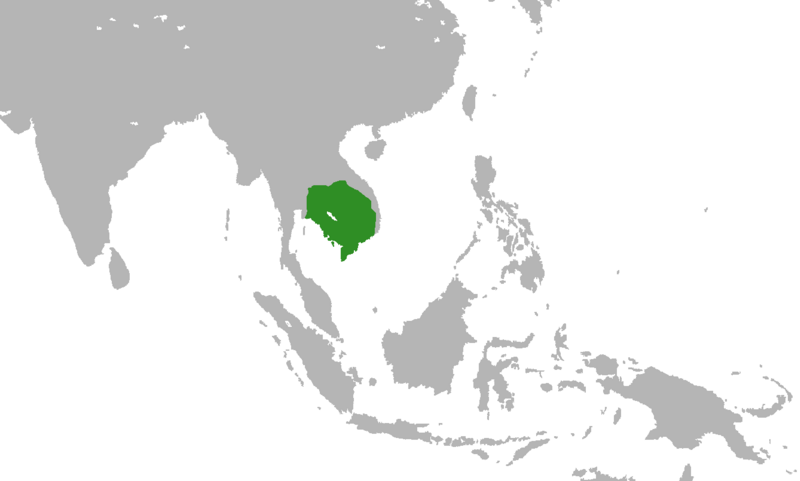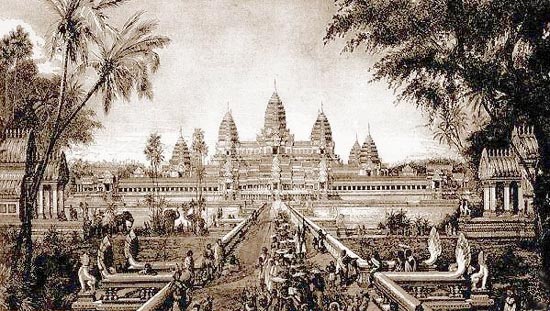Chenla (simplified Chinese: 真腊; traditional Chinese: 真臘; pinyin: ZhÄ"nlà ; Wadeâ€"Giles: ChÄ"n-là ; Khmer: áž…áŸáž"ឡា; Vietnamese: Chân Lạp) is the Chinese designation for Cambodia after the fall of Funan. That name was still used in the 13th century by the Chinese envoy Zhou Daguan, author of The Manners and Customs of Cambodia. Some modern scholars used the name exclusively for Khmer states of the period from the late 6th to the early 9th centuries. The Chenla kingdom was influenced by the cultures of the south Indian Pallava dynasty and Chalukya dynasty.
The beginnings of the so-called "Dangrek Chieftains" small chiefdoms north and south of the Dangrek Mountains are obscure. The first known princes are mentioned in some early inscriptions. The Sanskrit inscription of Vãl Kantél, Stung Treng province names a king VÄ«ravarman as father of a princess whose name was not mentioned, married to a Brahmin called SomaÅ›arman and sister of a certain Bhavavarman. According to the inscription from Čăn Năk’ôn in Basăk/Laos (K. 363) VÄ«ravarman was also father of prince Citrasena who was the younger brother of Bhavavarman. Obviously both princes had the same mother, but different fathers, which was corroborated by the Si Tep inscription (in present-day Thailand) giving the information that Bhavavarman was the son of a PrathivÄ«ndravarman and grandson of a Cakravartin whereas the inscription from Pak Mun in Ubon/Thailand informs us that the name of the father of VÄ«ravarman was called SÄrvabhauma. All these inscriptions refer to a large territory ruled by these kings. It is recorded in the inscription from Robaá¹… Romãs at ĪśÄnapura (the archaeological site of Sambor Prei Kuk) that a certain Narasiṃhagupta, who was vassal (samÄntaná¹›pa) of the successive kings Bhavavarman, Mahendravarman (the ruling name of Citrasena) and ĪśÄnavarman erected on 13 April 598 during the reign of Bhavavarman a figure of KalpavÄsudeva (Vishnu). This coincides with the oldest Chinese text that mentions Chenla, the Suà shÅ« (Annals of the Suà Dynasty), compiled by Wèi ZhÄ"ng (580-643) in AD 636, which gives the information that at the beginning of the 7th century Chenla was ruled by Citrasena and ĪśÄnavarman. The capital of the latter was ĪśÄnapura, while his predecessor Bhavavarman I still resided at Bhavapura, a place which probably is located in the vicinity of the modern town of Thala Barivat (13°33’ N, 105°57’ E).
History

It was ĪśÄnavarman who managed to absorb the ancient territories of Fúnán which led the XÄ«n Táng shÅ« (New History of the Táng Dynasty) (æ–°å"書), compiled by ÅŒuyáng XiÅ« (æ陽修) (1007â€"1072) and Sòng Qà (宋ç¥) (998-1061) in 1060 AD to attribute the effective conquest of the country to him. The earliest known date of the reign of ĪśÄnavarman, a date that must not have been long after his accession, is that of his first embassy to China to the court of the Suà in 616-17. This king is also known from his own inscriptions, one incised at ĪśÄnapura, dated 13 September 627 AD (K. 604), the other one at Khău Nôy (Thailand), dated 7 May 637 (K. 506). After ĪśÄnavarman, who ceased to reign around 637, the inscriptions tell us of a king named Bhavavarman (II). The only dated inscriptions we have from him, are that of Tà Kev (K. 79), dated 5 January 644 and of PoÃ±Ä Hòr south of Tà Kev (K. 21), dated Wednesday, 25 March 655. Then seemingly follows a certain king Candravarman, known from the undated inscription K. 1142 of unknown origin who hailed from the family of ĪśÄnavarman. The son of Candravarman was the famous king Jayavarman I whose earliest inscriptions are from Tûol Kôk Práḥ, province Prei Vêṅ (K. 493) and from Bà sêt, province Bằttaṃbaá¹… (K. 447), both dated 14 June 657. Some 19 or 20 inscriptions dating from his reign have been found in an area extending from Vat Phu'u in the north to the Gulf of Siam in the south. According to the XÄ«n Táng shÅ« the kingdom of ZhÄ"nlà had conquered different principalities in Northwestern Cambodia after the end of the Chinese reign period yÇ'nghuÄ« (永徽) (i. e. after 31 January 656), which previously (in 638/39) paid tribute to China. The reign of Jayavarman I lasted about thirty years and ended perhaps after 690. It seems that after the death of Jayavarman I (his last known inscription K. 561 is dated 681/82), turmoil came upon the kingdom and at the start of the 8th century, the kingdom broke up into many principalities. The region of Angkor was ruled by his daughter, Queen JayadevÄ« who complained in her Western Bà rà y inscription K. 904, dated Wednesday, 5 April 713, of "bad times". The Táng histories tell us that after the end of the reign period shénlóng (神é¾) (i. e. after 6 February 707) ZhÄ"nlà came to be divided in two realms, LùzhÄ"nlà (陸真臘) ("Land ZhÄ"nlà ", also called WèndÄn (文單) or Pólòu (婆é¤)) and ShuÄ«zhÄ"nlà (水真臘) ("Water ZhÄ"nlà ") and returned to the anarchic state that had existed before it was unified under the kings of Fúnán and the first kings of ZhÄ"nlà .
Kings like Åšrutavarman and Åšreá¹£á¹havarman or Puá¹£karÄká¹£a are only attested very much later in Angkorian inscriptions; their historicity is doubtful, All we know about Land ZhÄ"nlà is that it sent an embassy to China in 717. Another embassy visiting China in 750 came probably from Water ZhÄ"nlà . According to the Chinese Annals a son of the king of WèndÄn had visited Chinas in 753 and joined a Chinese army during a campaign against the kingdom of NánzhÄo (å—è©") in the following year. After the WèndÄn embassy in the year 771 the heir apparent Pómà (婆彌) came to the imperial court and, on 13 December 771, he received there the title KÄifÇ"yÃtóngsÄnsÄ« (開府儀åŒä¸‰å¸) ("Palace Opener who enjoys the same honours as the three higher officers"). In 799 an envoy from WèndÄn called LÄ«tóujà (æŽé åŠ) received a Chinese title, too. As rulers of Åšambhupura are attested by the inscription K. 124, dated 803/04 a king Indraloka and three successive queens, Ná¹›patendradevÄ«, JayendrabhÄ and Jyeá¹£á¹hÄryÄ. Two inscriptions refer to a ruler named Jayavarman: the first one, K. 103, hails from Práḥ Thãt Práḥ SrÄ•i south of Kompoá¹… Čà ṃ, dated 20 April 770, the second one from LobÅ’k Srót in the vicinity of KraÄèḥ near Åšambhupura (K. 134), dated 781). CÅ"dès called him Jayavarman Ibis, but probably he is identical with Jayavarman II, the founding father of the Angkorian kingdom, as Vickery has pointed out: "Not only was Jayavarman II from the South; more than any other known king, he had particularly close links with VyÄdhapura. This place is recorded in only one pre-Angkor inscription, K. 109/655 [exactly: 10th February 656], but in 16 Angkor-period texts, the last dated 1069 [K. 449 from Pà lhà l, dated Sunday, 3rd May 1069] … Two of them, K. 425/968 and K. 449/1069, are explicit records of Jayavarman II taking people from VyÄdhapura to settle in Battambang".
List of rulers

Notes
- ^ Some Aspects of Asian History and Culture by Upendra Thakur p.2
- ^ Vickery, Society, Economics, and Politics in pre-Angkor Cambodia, pp. 71 ff.
- ^ ISCC, No. IV, pp. 28 ff.
- ^ Barth, "Inscription sanskrite du Phou Lokhon (Laos)", pp. 37-40
- ^ IC, VII, pp. 156-157
- ^ Seidenfaden, «Complément à l’inventaire descriptif des Monuments du Cambodge pour les quatre provinces du Siam Oriental», p. 57
- ^ CÅ"dès, «Études Cambodgiennes XXXVI: Quelques précisions sur la fin de Fou-nan», pp. 5-8
- ^ Pelliot, "Le Fou-nan.", p. 272
- ^ Lévy,«Thala BÅrivăt ou Stu’ṅ Trèṅ: sites de la capitale du souverain khmer Bhavavarman Ier», pp. 113-129
- ^ Finot, «Nouvelles inscriptions du Cambodge», pp. 44 ff.
- ^ IC, Vol. V, p. 23
- ^ IC II, pp. 69 ff.
- ^ The Sanskrit text and a French translation was published in ISCC, pp. 21-26, the Khmer text and a French translation in IC V, pp. 5-6
- ^ MÉC I, 47-53
- ^ IC II, pp. 149-152
- ^ IC II, pp. 193-195
- ^ Wolters, "North-western Cambodia in the seventh century", p. 356 and pp. 374-375
- ^ IC I, pp. 39-44
- ^ IC IV, 54-63
- ^ Pelliot, «Deux itinéraires de Chine en Inde à la fin du VIIIe siècle», p. 211
- ^ Pelliot, «Deux itinéraires de Chine en Inde à la fin du VIIIe siècle», p. 212
- ^ IC III, pp. 170-174
- ^ IC V, p. 33
- ^ IC II, pp. 92 ff.
- ^ Vickery, Society, Economics, and Politics in pre-Angkor Cambodia, p. 396
References
- A[uguste] Barth, «Inscription sanskrite du Phou Lokhon (Laos)», Album Kern; opstellen geschreven ter eere van H[endrik] Kern, Leiden: E.J. Brill 1903, pp. 37â€"40.
- George CÅ"dès,«Études Cambodgiennes XXXVI: Quelques précisions sur la fin de Fou-nan», Bulletin de l'École Française d'Extrême Orient XLIII (1943), pp. 1â€"8.
- Louis Finot, «Nouvelles inscriptions du Cambodge», Bulletin de l'École Française d'Extrême Orient XXVIII (1928), pp. 43â€"80.
- IC = Inscriptions du Cambodge. Éditées et traduites par G[eorge] CÅ"dès. Vol. I-VIII. Hanoi, Paris: Impr. Extrême-Orient; de Boccard [etc.] 1937-1966 (Collection de Textes et Documents sur l’Indochine: III).
- ISCC = Inscriptions sanscrites de CampÄ et du Cambodge. [Éd. et trad.] par Abel Bergaigne et A[uguste] Barth. Paris: Klincksieck 1885-93.
- Paul Lévy,«Thala BÅrivăt ou Stu’ṅ Trèṅ: sites de la capitale du souverain khmer Bhavavarman Ier», Journal Asiatique 258 (1970), pp. 113â€"129.
- MÉC = Manuel d’épigraphie du Cambodge. Yoshiaki Ishizawa, Claude Jacques, Khin Sok. Avec la collaboration de: Uraisi Varasarin, Michael Vickery, Tatsuro Yamamoto. Vol. I, Paris: École Français d’Extrême-Orient 2007.
- Paul Pelliot, «Le Fou-nan.» Bulletin de l'École Française d'Extrême Orient III (1903), pp. 248â€"303.
- Paul Pelliot, «Deux itinéraires de Chine en Inde à la fin du VIIIe siècle», Bulletin de l'École Française d'Extrême Orient IV (1904), pp. 131â€"413.
- Erik Seidenfaden, «Complément à l’inventaire descriptif des Monuments du Cambodge pour les quatre provinces du Siam Oriental», Bulletin de l'École Française d'Extrême Orient XXII (1922), pp. 55â€"99.
- Michael Vickery, Society, Economics, and Politics in pre-Angkor Cambodia: The 7th-8th centuries. Tokyo: The Center for East Asian Cultural Studies for Unesco, The Toyo Bunko, 1998.
- O[liver] W[illiam] Wolters, "North-western Cambodia in the seventh century", Bulletin of the School of Oriental and African Studies 37 (1974), pp. 355â€"384.
